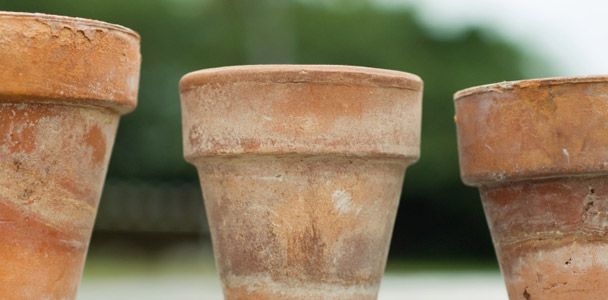We may be compensated if you purchase through links on our website. Our team is committed to delivering honest, objective, and independent reviews on home products and services.
While terra-cotta pots are a classic choice for gardeners, you may want a weathered, vintage look without waiting years to achieve the perfect patina. This do-it-yourself (DIY) project is simple, affordable, and can transform your planters in just a few hours. Here’s how to age a terra-cotta pot and create that coveted antique appearance for your garden or indoor plants.
Tools and Materials for Aging a Terr-Cotta Pot
Gather the following tools and materials before starting your project:
- Bowl: Choose a glass or plastic bowl that’s large enough to mix your lime solution. The bowl should be easy to clean and handle.
- Garden lime: This is available at most garden centers or home improvement stores.
- Gloves: Always wear gloves to protect your hands from the lime mixture and sealer.
- Protective face mask: A mask is essential for safety when sanding and spraying sealer.
- Matte sealer spray: Choose a clear, matte finish sealer designed for use on porous surfaces.
- Sandpaper: Medium-grit sandpaper is ideal for smoothing the surface and creating a weathered look.
- Stir sticks: Wooden paint stirrers or disposable utensils work well for mixing the lime paste.
- Water: Mix water with the garden lime to achieve the perfect consistency.
- Drop cloth or newspaper: Use a drop cloth or newspaper to protect your work surface.
- Foam paintbrush (1-inch): This type of brush allows for smooth, even application of the lime mixture.
Steps To Achieve the Perfect Lime Look for a Terra-Cotta Pot
The following method consists of a mixture of garden lime and water to create a weathered look, followed by sealing the pot to protect the finish. By following these steps, you can achieve a beautifully aged terra-cotta pot.
Step 1: Stir the Mixture

Create the lime mixture that will give your pot a weathered look. Here’s how to prepare the solution:
- In a bowl, combine equal parts garden lime and water to create a 50:50 ratio.
- Stir the mixture until you achieve a paste-like consistency. Aim for a smooth paste without any lumps.
- The consistency of your mixture will affect the final look of your aged pot. A thinner mixture will create a more subtle effect, while a thicker paste will result in a more pronounced aged appearance. If the mixture is too thick, gradually add small amounts of water until it reaches a consistency that you can easily apply with a foam brush.
Step 2: Apply the Solution
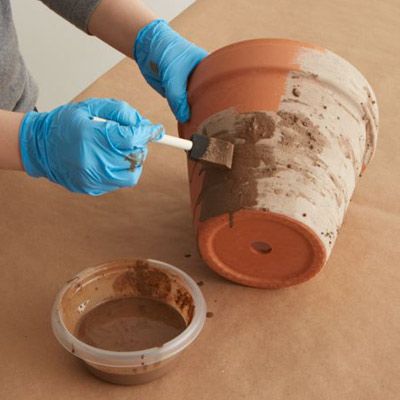
Once you’ve prepared your lime mixture, use a foam brush to apply a thick, even layer of the lime solution across the pot’s entire surface. Pay special attention to the rim, base, and any decorative elements on the pot.
If needed, apply a second layer for a more intense aged effect. Allow each layer to dry slightly before applying the next layer to prevent drips and achieve even coverage. For a more natural look, vary the thickness of the application in different areas. This will mimic the uneven weathering that occurs naturally over time.
Step 3: Sand the Pot
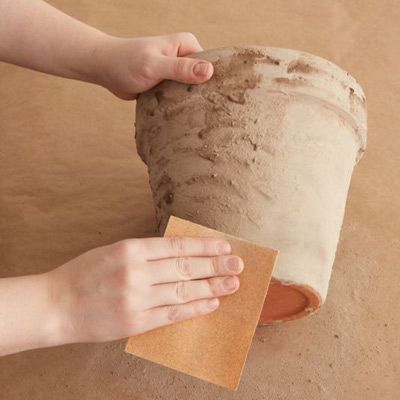
After the lime mixture has dried completely, sand the pot to create a more authentic aged appearance. Here are a few tips to keep in mind during this stage:
- Focus on edges and raised areas where natural weathering would occur more prominently.
- Remember to sand lightly in some spots to allow more of the original terra-cotta color to show through.
- Sand some areas more aggressively than others to create an uneven, natural-looking finish.
- Use medium-grit sandpaper to smooth out any rough spots or gritty areas on the pot’s surface.
Since you’ll be sealing the pot with a spray that will remove some of the lime, leave more of the lime mixture on the pot than you’d like to see in the final result.
Step 4: Seal the Surface
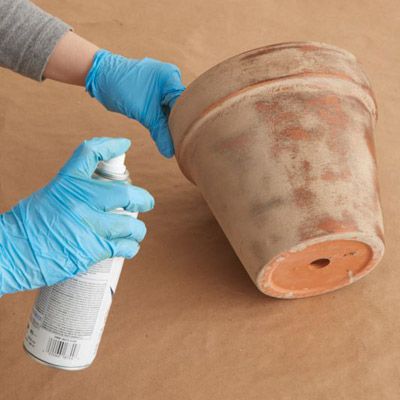
Sealing your aged terra-cotta pot will protect the finish and prevent moisture from seeping through the pot. Follow these steps to seal the surface:
- Put on a protective face mask and gloves.
- Apply a matte sealer spray in quick, light passes to avoid drips or pooling. Ensure even coverage by spraying from different angles.
- Aim for 3–4 thin layers of sealer for the best protection.
- Allow each layer to dry to the touch before applying the next coat.
Step 5: Finish Sealing
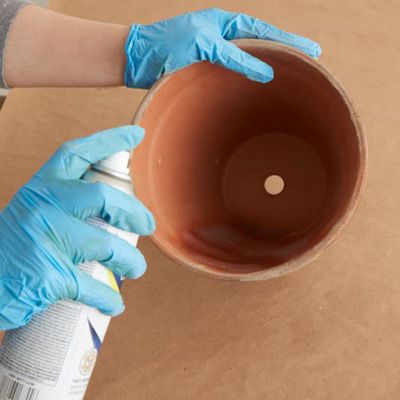
Once you’ve sealed and dried the exterior, turn the pot over to seal the inside and bottom. Apply the matte sealer to these areas using the same technique as before. Don’t add sealer to the drainage hole, and let the pot dry in a well-ventilated area before using it.
Additional Tips for Aging Terra-Cotta Pots
To achieve the best-aged results for your terra-cotta pot, consider these additional tips:
- Create depth by dry-brushing acrylic paint in earth tones over the dried lime mixture before sealing.
- Experiment with different application techniques, such as dabbing or sponging, to create unique textures.
- For a mossy look, apply a mixture of buttermilk and moss spores to select areas after sealing.
- Try mixing a small amount of concrete colorant into your lime mixture for a subtle tint.
Caring for Your Aged Terra-Cotta Pot
Once you’ve successfully aged your terra-cotta pot, proper care will help maintain its appearance. Avoid harsh scrubbing or power washing, which can remove the aged finish. When you clean the pot, gently dust or wipe it with a soft, damp cloth. If you’re keeping your pot outdoors, bring it indoors during the winter to prevent cracking. Reapply the sealer annually to preserve the aged look.
Our Conclusion
Aging a terra-cotta pot is a simple way to add character to your garden or indoor plant display. With just a few materials and some creativity, you can transform new pots into charming, vintage-looking planters.
